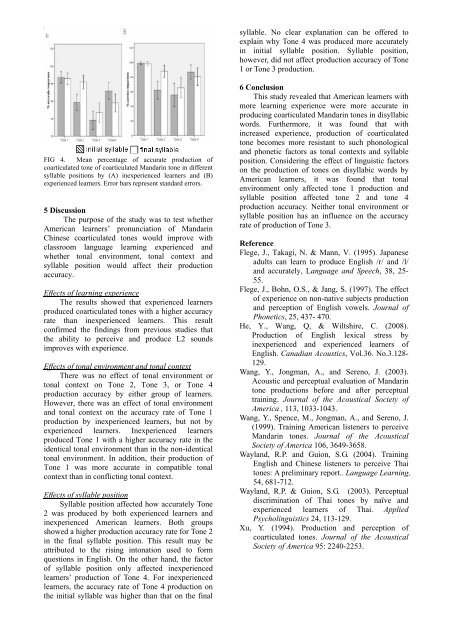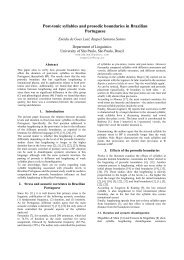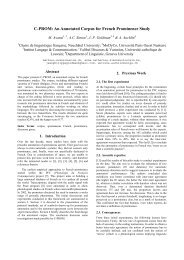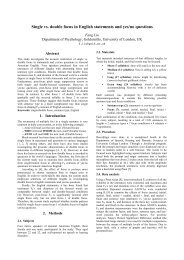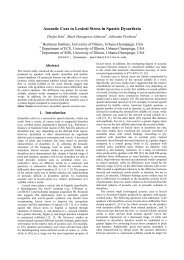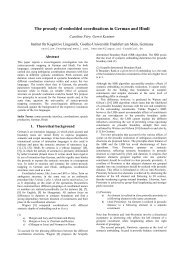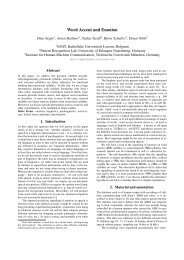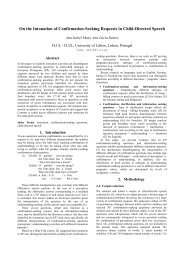The Production of Mandarin Coarticulated Tones by Inexperienced ...
The Production of Mandarin Coarticulated Tones by Inexperienced ...
The Production of Mandarin Coarticulated Tones by Inexperienced ...
You also want an ePaper? Increase the reach of your titles
YUMPU automatically turns print PDFs into web optimized ePapers that Google loves.
syllable. No clear explanation can be <strong>of</strong>fered toexplain why Tone 4 was produced more accuratelyin initial syllable position. Syllable position,however, did not affect production accuracy <strong>of</strong> Tone1 or Tone 3 production.FIG 4. Mean percentage <strong>of</strong> accurate production <strong>of</strong>coarticulated tone <strong>of</strong> coarticulated <strong>Mandarin</strong> tone in differentsyllable positions <strong>by</strong> (A) inexperienced learners and (B)experienced learners. Error bars represent standard errors.5 Discussion<strong>The</strong> purpose <strong>of</strong> the study was to test whetherAmerican learners’ pronunciation <strong>of</strong> <strong>Mandarin</strong>Chinese coarticulated tones would improve withclassroom language learning experienced andwhether tonal environment, tonal context andsyllable position would affect their productionaccuracy.Effects <strong>of</strong> learning experience<strong>The</strong> results showed that experienced learnersproduced coarticulated tones with a higher accuracyrate than inexperienced learners. This resultconfirmed the findings from previous studies thatthe ability to perceive and produce L2 soundsimproves with experience.Effects <strong>of</strong> tonal environment and tonal context<strong>The</strong>re was no effect <strong>of</strong> tonal environment ortonal context on Tone 2, Tone 3, or Tone 4production accuracy <strong>by</strong> either group <strong>of</strong> learners.However, there was an effect <strong>of</strong> tonal environmentand tonal context on the accuracy rate <strong>of</strong> Tone 1production <strong>by</strong> inexperienced learners, but not <strong>by</strong>experienced learners. <strong>Inexperienced</strong> learnersproduced Tone 1 with a higher accuracy rate in theidentical tonal environment than in the non-identicaltonal environment. In addition, their production <strong>of</strong>Tone 1 was more accurate in compatible tonalcontext than in conflicting tonal context.Effects <strong>of</strong> syllable positionSyllable position affected how accurately Tone2 was produced <strong>by</strong> both experienced learners andinexperienced American learners. Both groupsshowed a higher production accuracy rate for Tone 2in the final syllable position. This result may beattributed to the rising intonation used to formquestions in English. On the other hand, the factor<strong>of</strong> syllable position only affected inexperiencedlearners’ production <strong>of</strong> Tone 4. For inexperiencedlearners, the accuracy rate <strong>of</strong> Tone 4 production onthe initial syllable was higher than that on the final6 ConclusionThis study revealed that American learners withmore learning experience were more accurate inproducing coarticulated <strong>Mandarin</strong> tones in disyllabicwords. Furthermore, it was found that withincreased experience, production <strong>of</strong> coarticulatedtone becomes more resistant to such phonologicaland phonetic factors as tonal contexts and syllableposition. Considering the effect <strong>of</strong> linguistic factorson the production <strong>of</strong> tones on disyllabic words <strong>by</strong>American learners, it was found that tonalenvironment only affected tone 1 production andsyllable position affected tone 2 and tone 4production accuracy. Neither tonal environment orsyllable position has an influence on the accuracyrate <strong>of</strong> production <strong>of</strong> Tone 3.ReferenceFlege, J., Takagi, N. & Mann, V. (1995). Japaneseadults can learn to produce English /r/ and /l/and accurately, Language and Speech, 38, 25-55.Flege, J., Bohn, O.S., & Jang, S. (1997). <strong>The</strong> effect<strong>of</strong> experience on non-native subjects productionand perception <strong>of</strong> English vowels. Journal <strong>of</strong>Phonetics, 25, 437- 470.He, Y., Wang, Q, & Wiltshire, C. (2008).<strong>Production</strong> <strong>of</strong> English lexical stress <strong>by</strong>inexperienced and experienced learners <strong>of</strong>English. Canadian Acoustics, Vol.36. No.3.128-129.Wang, Y., Jongman, A., and Sereno, J. (2003).Acoustic and perceptual evaluation <strong>of</strong> <strong>Mandarin</strong>tone productions before and after perceptualtraining. Journal <strong>of</strong> the Acoustical Society <strong>of</strong>America , 113, 1033-1043.Wang, Y., Spence, M., Jongman, A., and Sereno, J.(1999). Training American listeners to perceive<strong>Mandarin</strong> tones. Journal <strong>of</strong> the AcousticalSociety <strong>of</strong> America 106, 3649-3658.Wayland, R.P. and Guion, S.G. (2004). TrainingEnglish and Chinese listeners to perceive Thaitones: A preliminary report.. Language Learning,54, 681-712.Wayland, R.P. & Guion, S.G. (2003). Perceptualdiscrimination <strong>of</strong> Thai tones <strong>by</strong> naïve andexperienced learners <strong>of</strong> Thai. AppliedPsycholinguistics 24, 113-129.Xu, Y. (1994). <strong>Production</strong> and perception <strong>of</strong>coarticulated tones. Journal <strong>of</strong> the AcousticalSociety <strong>of</strong> America 95: 2240-2253.


